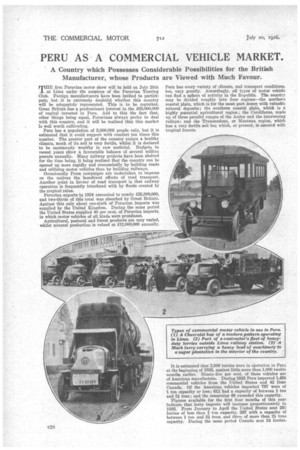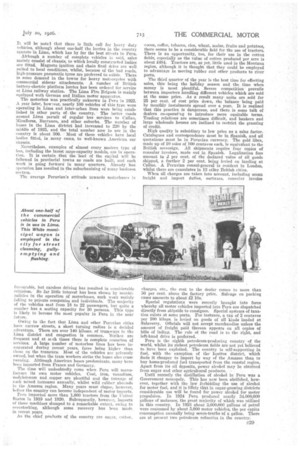PERU AS A COMMERCIAL VEHICLE MARKET.
Page 12

Page 13

If you've noticed an error in this article please click here to report it so we can fix it.
A Country which Possesses Considerable Possibilities for the British Manufacturer, whose Products are Viewed with Much Favour.
MHE first Peruvian motor show will be held on july 28th at Lima unler the auspices of the Peruvian Touring Club. Foreign manufacturers have been invited to participate, but it is extremely doubtful whether this country will be adequately represented. This is to be regretted. Great Britain has a predominant interest in the £60,000,000 of capital invested in Peru. Add to this the fact that, other things being equal, Peruvians always prefer to deal with this country, and it will be realized that this market Is well worth cultivating.
Peru has a population of 5,000,000 people only, but it is estimated that it could support with comfort ten times this number. The greater part of the country enjoys a healthy climate, much of its soil is very fertile, whilst it is declared to be enormously wealthy in raw material. Budgets in recent years show it favourable balance of several million pounds annually. Many railway projects have been shelved for the time being, it being realized that the country can be opened up more rapidly and economically by building roads and utilizing motor vehicles than by building railways.
Occasionally Press campaigns are undertaken to impress on the natives the beneficent effeets of road transport. Another point in fat our of road transport is that railway operation is frequently interfered with by floods created by the tropical rains.
Peruvian exports in 1924 amounted to nearly £25,000,000, and two-thirds of this total was absorbed by Gloat Britain. Against this only about one-sixth of Peruvian imports was supplied by the United Kingdom. During the same period the United States supplied 40 per cent. of Peruvian imports, in which motor vehicles of all kinds were prominent.
Agricultural, pastoral and forest products are very varied, whilst mineral production is valued at £12,000,000 annually. Peru has every variety of climate, and transport conditions, too, vary greatly. Accordingly, all types of motor vehicle can find a sphere of activity in the Republic. The country may be divided roughly into four regions—the northern coastal plain, which is for the most part desert with valuable mineral deposits; the southern coastal plain, which is a highly potential agricultural region; the Cordilleras, made up of three parallel ranges of the Andes and the intervening valleys ; and the Trruasandean, or Montana region, which has a very fertile soil but which, at present, is covered with tropical forests.
It is estimated that 2,500 lorries were in operation in Peru at the beginning of 1926, against little more than 1,000 twelve months earlier. Ninety-five per cent. of these vehicles are of American manufacture. During 1925 Peru imported 1,458 commercial vehicles from the United States and 42 from Canada. Of the American vehicles imported 797 were of 1 ton capacity or less; 612 had a capacity of between 1 ton and 21 tons ; and the remaining 49 exceeded this capacity.
Figures available for the first four months of this year indicate that lorry imports will increase proportionately in 1926. From January to April the United States sent 295 lorries of less than 1 t.m capacity, 267 with a capacity of between 1 ton and 2 tons, and three of more than 2i tons capacity. During the same period Canada sent 24 lorries. It will be noted that there is little call for heavy duty vehicles, although about one-half the lorries in the country operateln Lima, which has by far the best streets in Peru.
Although a number of complete vehicles is sold, sales mainly consist of chassis, to which ioeu11y constructed bodies are fitted. Magneto ignition and chain final (hive are well suited to local conditions, whilst, because of the bad roads, high-pressure pneumatic tyres are preferred to solids. There is some demand in the towns for heavy motorcycles with commercial sidecar attachments. A number of British battery-electric platform lorries has been ordered for service at Lima railway station. The Lima Fire Brigade is mainly equipped with German and Italian motor apparatus. The motorbus was practically unknown in Peru in 1922. A year later, how wer, nearly 100 .vehicles of this type were operating in Lima and inter-urban lines were being established in other parts of . the country. The better roads around Lima permit of regular bus services to Callao, ltliraflores, Barnum°, and other suburbs. The number of buses in the Lima district had increased to 220 by the middle of 1925, and the total number now in use in the country is about 300. • Most of these vehicles have local bodies fitted, in many cases, to well-known American car chassis. .
Nevertheless, examples of almost every modern type of bus, including the latest large-capacity models, are in-operation. It is certain that the lead of the capital will be followed in provincial towns as roads au built, and such work is going forivarain many quarters. Already bus operation has resulted in the suburbanizing of many business eeetres.
The average Peruvian's attitude towards motorbuses favourable, but .careless driving has resulted in considerable criticism. So fax little interest has been shown by municipalities in the operation of motorbuses such work mainly falling to private compade,s and individuals. The majority of the vehicles seat from 18 to 22 passengers, but quite a number has a seating capacity for 30 persons. This type is likely to become the most popular in Peru in the near future.
Owing to the fact that Lima and other Peruvian cities have narrow streets,. a -short turning radius is a decided advantage. There are over 140 kiloms. of tramways in the Lima district and congestion is common. 'Strikes are frequent and at et eh times there is complete cessation of services. A large. number of motorbus lines has been inaugurated during recent' years, fares being higher than those on the tramcars. Most of the vehicles are privately owned, but when the tram workers strike the buses also cease running. Although American buses predominate, many have been imported from Prance and Germany:
The time will undoubtedly come when Peru will manufacture its own motor vehicles. Coal, iron, vanadium, molybdenum and..copper are plentiful and the tonnage of each mined increases annually, whilst wild rubber abounds in the Amazon region. Many years must elapse, however, before the country can become independent of motor imports.
Peru imported more than 1,000 tractors from the United States in 1919 and 1920. Subsequently, however, imports of these machines slumped to a remarkable extent, owing to overstocking, although some recovery has been made . in recent years.
As the chief products of the country are sugar, cotton, cocoa, coffee, tobacco, rice, wheat, maize, fruits and potatoes, there seems to be a considerable field for the use of tractors. There is an opportunity, too, for their use in the cotton fields, especially as the value of cotton produced per acre is about £484. Tractors are, as yet, little used in the Montana region, although it is thought that they could be employed to advantage in moving rubber and other products to river ports.
The third quarter of the year is the best time for effecting sales, this being the holiday season and the time when money is most plentiful. Severe competition prevails between importers handling different vehicles which are sold at the same price. As a result many units are sold for 25 per cent, of cost price down, the balance being paid by monthly instalments spread over a year. It is realized that this practice is dangerous, and there is some talk of dealers co-operat4ng to introduce more equitable terms. Trading relations are sometimes diffieult, and bankers and large wholesale houses are inclined to restrict the granting of credit.
High quality is subsidiary to low price as a sales factor. Catalogues and correspondence Must be in Spanish, and all quotations must be in Peruvian currency. The gold libra, made up of 10 soles of 100 centavos each, is equivalent to the British sovereign. All shipments require four copies of consular invoices, made out in Spanish. Legalization fees amount to 2 per cent, of the declared value of all goods shipped, a further 2 per cent. being levied on landing at Callao. A Peruvian consul-general is resident in London, whilst there are consulates in 13 other British cities.
When all charges are taken into account, including ocean freight and import duties, surtaxes, consular invoice charges, etc., the cost to the dealer comes to more than 50 per cent, above the factory price. Salvage on packing eases amounts to about £2 10s.
Special regulations were recently brought into force whereby all motor vehicles imported into Peru are dispatched directly from shipside to consignee. Special systems of taxation exists at some ports. For instance, a tax of 2 centavos Per 100 kilogs. is levied on goods of all kinds landed at Salaverry. Officials will not accept merchandise unless the amount of freight paid thereon appears on all copies of bills of lading. The rule of the road is to the right, and left-baud drive is preferred.
Peru is the eighth petroleum-producing country 'of the world, whilst its richest petroleum fields are not yet believed to have been exploited. The country is self-supporting in fuel, with the exception of the' Iquitos district, which finds it cheaper to import by way of the Amazon than to buy home-produced fuel transported from the coastal region. Apart from its oil deposits, power alcohol may be obtained from sugar and other agricultural products.
Until recently the distillation of alcohol in Peru was a Government monopoly. This has now been abolished, however, together with the law forbidding the use of alcohol for motor fuel, and it is likely that in sugar-growing districts considerable use will be found for power alcohol for motor propulsion. In 1924 Peru produced nearlY 34,000,000 gallons of molasses; the great majority of which was utilized in this country. In 1923 about 3,000,000 gallons of petrol were conSumed by about 5,000 motor vehicles, the per capita consumption annually Teeing seven-tenths of a gallon. There are at present two petroleum refineries in the country.






























